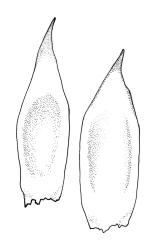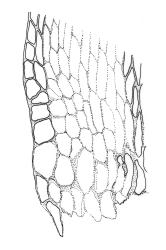- ≡ Leskea homomalla Hampe, Icon. Musc. [Hampe] Pl. 6 (1844)
- ≡ Hypnum homomallum (Hampe) Müll.Hal., Syn. Musc. Frond. 2, 336 (1851)
- ≡ Pylaisia homomalla (Hampe) A.Jaeger, Ber. Thätigk. St. Gallischen Naturwiss. Ges. 1876–1877: 307 (1878)
- ≡ Rhaphidorrhynchium homomallum (Hampe) Mitt., Trans. & Proc. Roy. Soc. Victoria 19: 84 (1882)
- ≡ Rhaphidostegium homomallum (Hampe) Broth. in Brotherus, Nat. Pflanzenfam. [Engler & Prantl] 1(3), 1114 (1908)
- = Hypnum drummondii Hook.f. & Wilson, London J. Bot. 3: 555 (1844)
Rhaphidostegium homomallum sensu Dixon 1929
Plants gold-brown, copper, yellow-green, dark brown, or occasionally bright green, lustrous, forming loosely interwoven mats, on rock or bark in coastal situations. Stems creeping, to c. 25 mm, irregularly branched, with numerous fascicles of smooth brown rhizoids on ventral surface, in cross-section lacking both a central strand and a hyaloderm. Branches short (c. 3 mm) and ± uniform in length, ± cuspidate, not flattened. Leaves strongly homomallous, pointing away from the substrate, oblong or broadly ovate-lanceolate, ± abruptly tapered to an acute and often weakly reflexed apex, weakly narrowed to insertion, concave, reflexed at upper margins, entire, c. 1.5–1.6 × 0.4–0.55 mm (under cover slip); mid laminal cells (upper third of leaf) linear-rhombic, ± rounded at ends, smooth, not porose, mostly c. 36–45(–60) × 6 µm, becoming gradually longer (to 60–90 µm or more) in lower leaf; cells at leaf base yellow to orange in a basal band, shorter and porose; alar group large and usually opaque, orange or hyaline, ± concave, extending laterally ¼ to nearly ⅓ the width of leaf and extending up margin for 6–8(–10) cells, ± abruptly differentiated from adjacent laminal cells; c. 3–4 cells in the extreme basal angle moderately enlarged, firm-walled, and oblong; the supra-alar cells numerous, subquadrate, and incrassate.
Probably dioicous. Perichaetia scattered on stems and branches, the inner leaves ovate-lanceolate, c. 1.3 mm, tapered to a narrowly acuminate apex. Perigonia scattered on stems, gemmiform and very small (c. 0.6 mm diam.). Setae yellow-orange, smooth, twisted to the left, 5–8 mm; capsules suberect, oblong-cylindric, 1.3–1.5 mm, constricted below mouth when dry; stomata few and restricted to neck, superficial; operculum finely rostrate from a conic base, c. 1 mm; exothecial cells collenchymatous, but with thickenings more pronounced on longitudinal walls, in ± distinct longitudinal ranks (rows not apparent under stereoscope); exostome teeth not or very weakly cross-striolate on lower outer surface, strongly papillose above, with very well-developed trabeculae on inner surface; endostome with a low membrane (c. ¼ the total height of the endostome) appearing smooth under the light microscope, the segments well-developed, nearly the length of the teeth, narrowly perforate; cilia single, stout, and scarcely nodose. Calyptra cucullate, smooth. Spores green, variable but not bimodal in a single capsule, mostly (12–)14–25 µm.
Brotherus 1925, fig. 738; Catcheside 1980, fig. 206; Ramsay et al. 2002, figs 15–17; Meagher & Fuhrer 2003, p. 83; Malcolm & Malcolm 2003, p. 63.
NI: N Auckland including offshore islands (TK, PK, HC, LB, GB, RT, The Noises), S Auckland (Tauranga, Cape Colville, Whale I.), Hawke’s Bay (Māhia Peninsula), Wellington (Tītahi Bay, Pt. Halswell, Turakirae Head, Mana I., Kapiti I.).
Australasian. Tasmania*, mainland Australia*. Recorded without details from "eastern Malesia and Oceania" by Ramsay et al. (2002, p. 29) and from New Caledonia by Brotherus (1925).
On rock or bark (often Metrosideros) or logs in coastal situations. Nearly all records from near sea level, but a few Poor Knights Is collections are recorded from c. 175 m. This is a common species in coastal areas of N Auckland but is apparently much less common south of this region. It is tolerant of some coastal salt spray and it is largely restricted to sites subject to salt spray in Wellington L.D. (P. Beveridge, pers. comm., Feb. 2003). Although most epilithic occurrences are on volcanic rock, collections by Sainsbury from the Māhia Peninsula (Hawke’s Bay L.D.) are from coastal limestone. Frequently associated species include Thuidiopsis furfurosa, Tortella cirrhata, Weissia controversa s.l., and Lepidolaena clavigera.
While largely restricted to coastal situations in N.Z., this species does not exhibit a coastal bias to its distribution in Tasmania or mainland Australia, as demonstrated by the distribution map of Ramsay et al. (2002, fig. 23, 2).
The plants have a neat and distinctive appearance due to the strongly homomallous (secund) and glossy leaves and the uniformity of the branch length. The leaf tips are often weakly reflexed and the narrowly reflexed upper margins of the leaves are apparent using a hand-lens. This species often grows in exposed and insolated sites and usually develops a strong and distinctive coppery colouration; plants that are yellow-green in colour are typically from shaded sites. As alluded to by Scott & Stone (1976, p. 445), this species is highly anomalous in Sematophyllum given its suberect capsules, its large, opaque alar groups, and probably dioicous sexuality. Further study may result in its exclusion from the genus.
This species is particularly difficult to sex convincingly. The statement by Ramsay et al. (2002) that it is dioicous is probably correct, although dioicous species are infrequent in Sematophyllum. In sparsely fruiting material (E. Whitehouse 29465 from near Point Halswell, Wellington L.D., CHR 265450) I have found both female and male stems, but have been unable to demonstrate organic connection between them. Capsules are rare in N.Z. and sporophyte features are described from L.B. Moore 592 from Rangitoto I., CHR 587225. Ramsay et al. (2002, p. 31) stated that in Australia sporophytes are "frequently found" in material from South Australia.
Sematophyllum homomallum is most likely to be confused with S. subhumile var. contiguum, but the present species differs by having (usually) strong secondary pigmentation, broader leaves, different alar cells, and dioicous sexuality, and by being largely confined to coastal situations.








